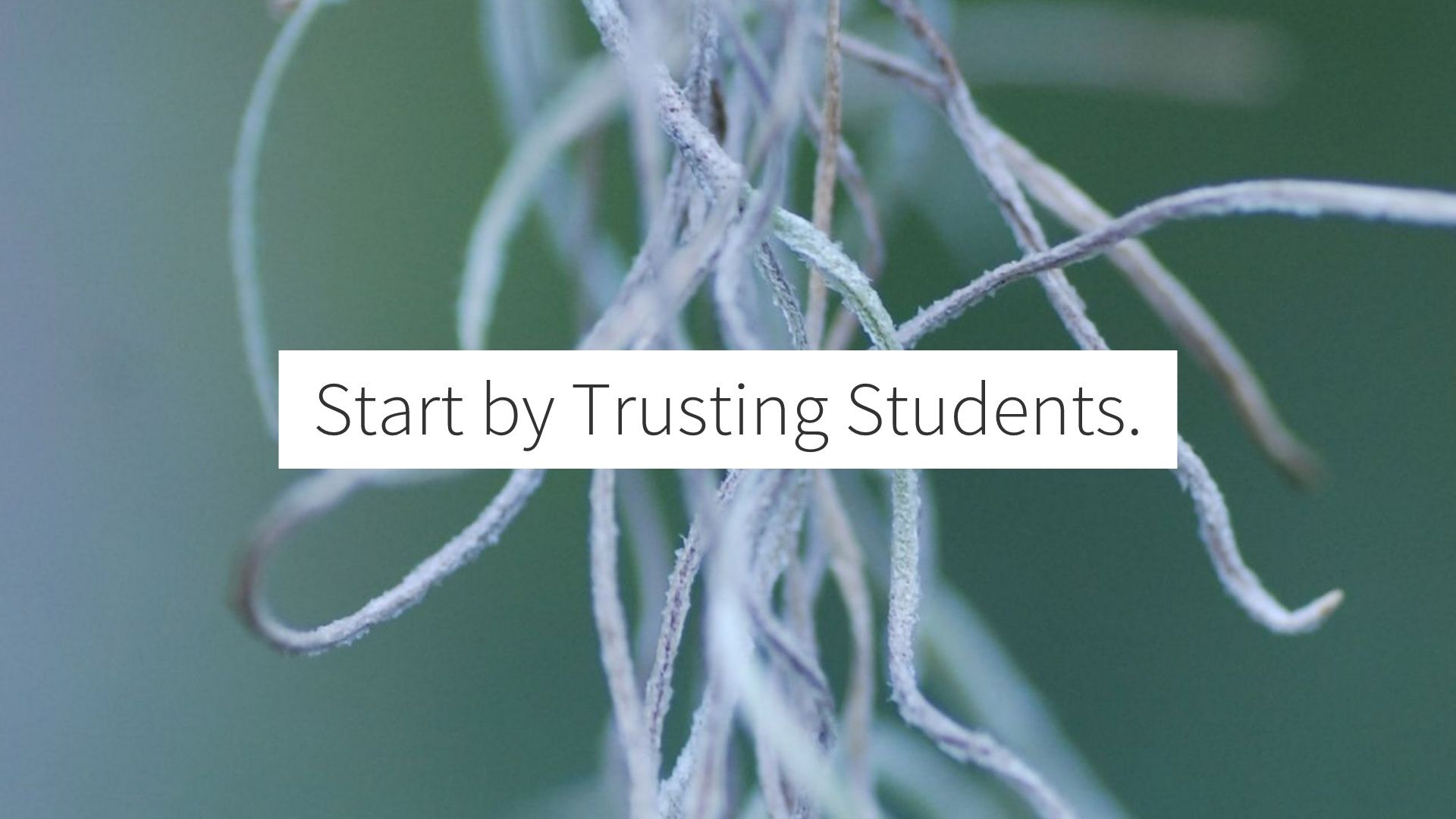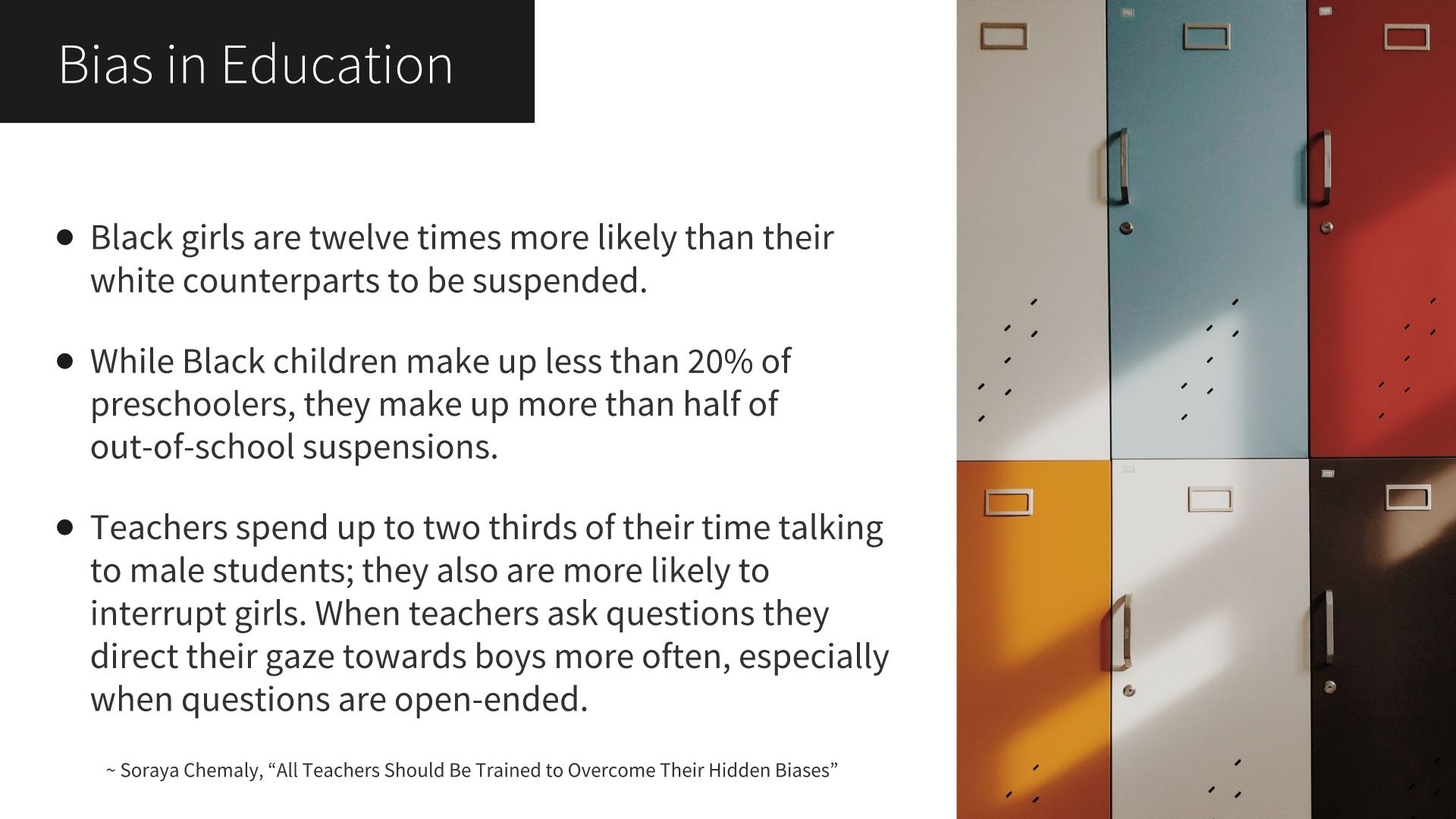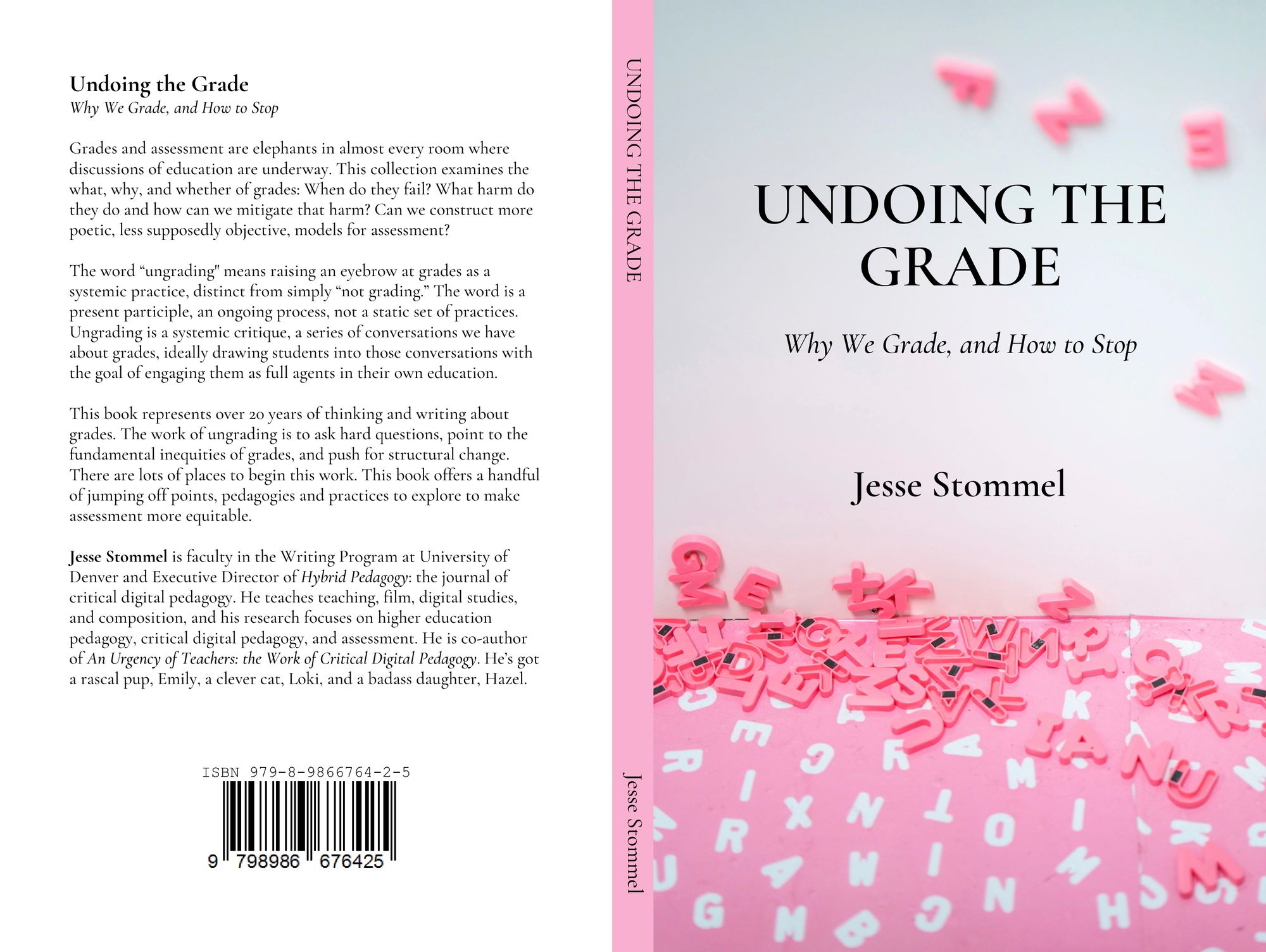Ungrading for Equity
This piece is an excerpt from my new book, Undoing the Grade: Why We Grade, and How to Stop. The book is available now in paperback and Kindle editions.
“There is consensus in the literature about the benefits of a student’s sense of belonging. Researchers suggest that higher levels of belonging lead to increases in GPA, academic achievement, and motivation.” ~ Carey Borkoski, "Cultivating Belonging"
Over the last several years, many of us have found ourselves feeling isolated and alone. I know this is how many of the students I work with are feeling. This is how I am feeling. I have heard from teachers around the world that they aren’t sure they want to be teachers anymore if this is what the work continues to look and feel like. I have heard from faculty members who feel overwhelmed by administrative indecision and continuing bureaucratic hurdles. I have talked to faculty who are seeing their institutions dismantled by a hostile state government. I have talked to students who have found the challenges of just living have made their schoolwork an afterthought. And I have also talked to students who feel increased anxiety about their schoolwork, grades, and GPAs, because these have become so conflated with their futures.
Many of the students we work with don’t know where they will find their next meal. The most marginalized students at our institutions are finding themselves and their work increasingly policed — by faculty members, by administrative policies, by ed-tech “solutions,” and by the actual police. The majority of faculty members in higher education are precariously employed. And many are afraid their institutions might close. Or, like me, they worked at institutions that have already closed.
As humans, as teachers, and as members of learning communities, we need to look around and be honest about the damage the last several years have wrought. More institutions will close. Staff will be laid off. Students will become sick. Cameras will be installed in classrooms, and disabled students will be made into flies on the wall for live-streamed lectures. Teachers will require homeless students to turn on their cameras during Zoom sessions. Some of those students will be marked absent if they refuse.
The moves back toward supposed “business as usual” have been made at the expense of marginalized students, staff, and faculty. We need to talk openly about different ways forward. And we need to be patient with ourselves and with each other.

Equity in Education
At the heart of my pedagogical approach is a belief that pedagogy, and especially assessment, needs to be a conversation, a “critical dialogue,” in the words of Paulo Freire. The classroom is a place for students and teachers to ask hard questions of one another, working together to reimagine the project of education, in order to help students (and teachers) become full agents in that education and in the broader culture in which they live.
Equity in education starts with small, human acts:
- Walk campus to assess accessibility of common spaces and classrooms. Accessible desks in each classroom don't do much good if students can’t get to them because the rooms are overcrowded.
- Include a basic needs statement in your syllabus that directs students to resources and encourages them to talk to you if they need help. Don't bury the statement at the end. Lead with it.
- Make sure there's a simple and well-advertised process for students, faculty, and staff to change their names in institutional systems and that chosen names are what appear on course rosters and ID cards.
- Regularly invite campus community into hard conversations about equity and access. For example, frank discussion of gender and race bias in grading and course evaluations.
As much as my work here is about grades, it has to be about so much more. When I run workshops about ungrading, we end up spending a good deal of time talking and writing about who our students are, what they need to be successful, and the kinds of relationships we want to build in education. Specifically, I ask,
Who do you teach? What do you know about your students? Who are they? How are they changing? What do they want from their education? What barriers do they face?
Then, I have us think about what we most need to communicate to our students:
What work do you value from students? What will you contribute (as the teacher)? What does success look like in your class? How (as the teacher) will you know when you’ve seen it? What is the students’ collective role in constructing the course? How will you show care for your students? How will you show care for yourself?
As a teacher, starting from a place of care is human, but it’s also pedagogical. Julianne Holt-Lunstad, et. al. write, "There is robust evidence that social isolation and loneliness significantly increase risk for premature mortality, and the magnitude of the risk exceeds that of many leading health indicators.” In order to build and support community, we must be willing to acknowledge trauma members of that community have and will experience.
Learning for Justice offers “A Trauma-Informed Approach to Teaching Through Coronavirus,” which is as relevant now as it was in 2020. They argue we need to:
- Establish a routine and maintain clear communication.
- Prioritize relationships and wellbeing over compliance.
- Actively encourage and support a sense of safety, connectedness, and hope.
- Acknowledge that trauma is not distributed equally.
Establishing clear communication shouldn’t be focused primarily on clarifying policies or instructions. What’s most important is that students know what to do if they’re struggling and where they can go for help. In “The Single Most Essential Requirement in Designing a Fall Online Course," Cathy N. Davidson writes, “From everything we know about learning, if the trauma is not addressed, accounted for, and built into the course design, we fail. Our students fail.”
Is Ungrading an Equitable Practice?
I’m often asked if ungrading is an equitable practice. Can pushing back against grades do harm to BIPOC students, neurodivergent students, non-traditional adult students? The question gives me pause when I hear it, because so many folks are unwilling to turn the same critical eye at grades. Grades are widely accepted as effective (or, at least, meaningful), even if much of the research indicates otherwise. Certainly, making any dramatic changes to our pedagogies without considering our marginalized students can do harm, but ungrading is an equitable practice because grades do harm. And marginalized students are the students most harmed by grades. Finding ways to reduce that harm, and to begin to dismantle grades as a system, is imperative if equity or justice is our goal.


Some neurodiverse students rely on extrinsic motivation or structure, but neurodiverse students are not a monolith, and ungrading is not at odds with structure. It asks hard questions of structures in education that do harm, like grades, arbitrary deadlines, standardized testing, ranking students against one another, inflexible policies, etc. One big problem of traditional grades is that they structure much of education.
Removing grades, though, doesn’t remove structure, just one kind of problematic structure. Adding flexibility for students and teachers also doesn’t remove structure. I’m disabled, neurodivergent, and need both flexibility and structure to succeed. Flexibility and structure are not at odds. Care and structure are not at odds. There are lots of mechanisms better than grades at providing structure for learners: a clear schedule, concise descriptions of class activities, clear ways to ask for help or feedback, community architecture that makes it easy for students to connect with each other. There are better structures than grades to support struggling students and teachers: student services, faculty development, a living wage for teachers, clear and direct communication between teachers and students, supports for collaboration and community rather than competition.
Structure, clear expectations, and boundaries are all good when we’re working to build and support community, trust, etc. At the same time, flexibility helps support diverse and marginalized students (and can also make the work of assessment easier for diverse and marginalized faculty). Flexibility can mean removing rigid due dates to create space for students to do work as they're able, or acknowledging and valorizing different kinds of participation, or offering students multiple paths to choose from as they work through a course. The key is to resist the notion that the shape of teaching and learning should be fixed in advance and standardized.
We need to re-examine our pedagogies when we remove grades, because grades (control, compliance, over reliance on extrinsic motivation) have too often been at the foundation of those pedagogies. Removing individual acts of grading without doing that larger work can leave grades as a system still mostly intact.
None of this happens all at once. And there is no one right first step. We can’t snap our fingers and dismantle grades as a system. I’ve been using alternative approaches to assessment for 23 years. I haven’t put a grade on a single piece of student work during that time, but the grade still hovers over every classroom I’ve taught in, because the system of grades is insidious. We can start by having conversations and asking hard questions of each other, and of ourselves. Or by minimizing the harm of grades (making them less arbitrary, bringing students into the assessment process, etc.).
Designing for Care
In the introduction to my recent book, I write that we should never "replace visible goalposts with invisible ones. To the extent that we can remove (or decenter) grades, we have to be sure we aren't just shifting the goalposts for students, replacing clear policies with hidden curriculum."

Some other tenets we can follow when designing for equity and care:
We have to start by seeing students as full humans, fully acknowledging their context and history. This requires structural change. Students can't be rows in a spreadsheet. A harm-reduction approach to assessment requires that we see each student (and each teacher) as unique, and that we see basic needs and pedagogical needs as inextricably linked. Static best practices, inflexible models, and stock curricula won’t help us.
We have to design for our most marginalized students: disabled students, chronically ill students, Black students, Indigenous students, queer students, students facing housing and food-insecurity, etc. We need to write flexible policies, imagine new ways forward, for students already struggling, already facing exclusion.
We need to anticipate rather than merely accommodating. It is our legal obligation to offer accommodations for students with disabilities; however, our work should go further toward creating flexible spaces that anticipate the needs of diverse students. The students struggling the most are the ones least likely to ask for help, the ones least likely to know what accommodations are available or how to secure them.
No learning is neatly quantifiable. Not all learning will be visible to teachers or institutions. Student work can't be columns in a spreadsheet. Policing behavior, tracking attention, and algorithmic surveillance are not teaching.
The work of teachers is precarious. The context and subject positions of teachers impact how we will and can do our work. Teachers need adequate preparation, support, and compensation. To administrators wanting to "innovate", I say, start by paying all teachers a living wage.
Instead of rewarding competition, pitting teachers and staff against one another, and normalizing bullying, institutions need to structurally support collaboration. If there is no way to compensate and valorize co-teaching, that's a structural defect.
Bringing students and teachers more fully into dialogue about assessment (and about education more broadly) is the most important, and most radical, change we can work toward. And if students don’t show up to these conversations, we need to ask ourselves what we’ve done to make them feel unwelcome.
These tenets can translate into practices: Start with hello, how are you?, Remind students a rug won't get pulled out from under them, create multiple points of entry, ask students to reflect on their own learning, etc. However, we ultimately need more conversations and fewer policies. Teaching should be about encouraging student learning not policing behavior. We can set boundaries, but we should keep our focus on natural consequences, not arbitrary ones, leaning into social contracts rather than lesson plans, rubrics, and grade books.




